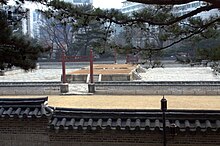

| Sajikdan | |
|---|---|

The shrine in 2014
| |
| Religion | |
| Affiliation | Korean Confucianism |
| Location | |
| Location | Seoul, South Korea |
| Geographic coordinates | 37°34′33″N 126°58′04″E / 37.5757°N 126.9677°E / 37.5757; 126.9677 |
| Architecture | |
| Date established | 1395 |
 | |
| Korean name | |
| Hangul | 사직단 |
| Hanja | 社稷壇 |
| Revised Romanization | Sajikdan |
| McCune–Reischauer | Sajiktan |
Sajikdan (Korean: 사직단) is a Neo-Confucian altar located in Sajik-dong, Jongno District, Seoul, South Korea.[1] It was built and used during the Joseon period to perform rituals related to soil and grain.[2][3]
When Seoul was founded during the Joseon period, the location of Sajikdan was prescribed by the ritual bureaucratic text Rites of Zhou.[1][4] The shrine was created in 1395.[4] Along with the royal palace Gyeongbokgung and the shrine Jongmyo, Sajikdan is a fundamental symbol of the new capital city.[4]
On this square altar were honored on key moments of the lunar calendar the national deities of earth (Sa) and grains (Jik).
Certain ceremonies have been recently revived in the square altars.
This article about a South Korean building or structure is a stub. You can help Wikipedia by expanding it. |
This article related to religion in Korea is a stub. You can help Wikipedia by expanding it. |
This Confucianism-related article is a stub. You can help Wikipedia by expanding it. |